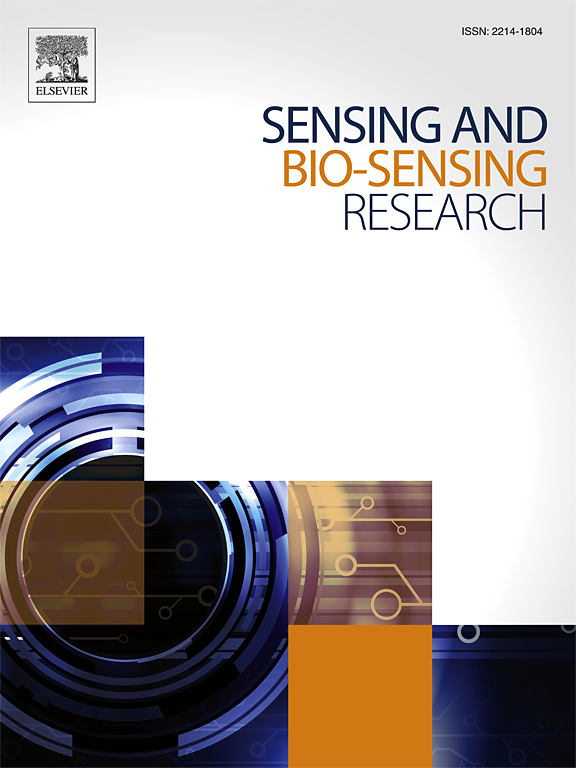在为期四天的长时间步行运动事件中,用于参与者尿液分析的自动厕所水合传感器:原型验证研究
IF 5.4
Q1 CHEMISTRY, ANALYTICAL
引用次数: 0
摘要
水分不足是老年人的常见问题,如果不及时治疗,可能会导致严重的健康并发症。然而,目前还没有足够的、非突发性的方法来自动监测水合不足状态。因此,开发了一种原型,可以在上厕所时自动测量尿液浓度。本研究验证了该原型能够重复准确地测量106名参与者的尿液,这些参与者参加了为期4天的长时间步行锻炼活动。该原型包含4个传感器,可以在参与者上厕所时测量尿液样本的颜色、电导率、pH值和温度。该样机总共分析了514份尿样。此外,尿液被自动收集以测量尿浓度、尿比重(USG)和渗透压的金标准。利用线性回归分类模型和USG参考,对原型采集的数据进行分类。测量的USG参考值范围在1.0025和1.0345之间。原型测量值与USG参考值密切相关,r平方为0.85,平均绝对误差为0.00215。因此,本研究报告了一种方法,可以在上厕所时自动、重复和准确地分析尿液。当日常使用时,该原型提供了通过监测尿液进行非突发性和时效性的水合不足估计的潜力。本文章由计算机程序翻译,如有差异,请以英文原文为准。
Automated in-toilet hydration sensor for urinalysis on participants during a four-day prolonged walking exercise event: Prototype validation study
Underhydration is a common problem in elderly, which can lead to serious health complications if left untreated. However, currently, there is no sufficient, non-obtrusive method to monitor underhydration status automatically. Therefore, a prototype was developed that automatically measures urine concentration during a toilet visit. This study validates this prototype for its capability to repeatedly and accurately measure the urine of 106 participants participating in a 4-day prolonged walking exercise event. The prototype contains 4 sensors that measure the color, conductivity, pH, and temperature of the urine sample while the participant uses the toilet. In total, the prototype analyzed 514 urine samples. In addition, the urine was automatically collected to measure the gold standard for urine concentration, urine specific gravity (USG), and osmolality. With a linear regression classification model and the USG reference, the data collected with the prototype was classified. The measured reference USG values range between 1.0025 and 1.0345. The prototype measurements strongly correlated to the USG reference, with an R-squared of 0.85 and a mean absolute error of 0.00215. As such, this study reports on a method that allows automated, repeated, and accurate urinalysis during a toilet visit. When used daily, this prototype offers potential for the non-obtrusive and time-effective underhydration estimation by monitoring urine.
求助全文
通过发布文献求助,成功后即可免费获取论文全文。
去求助
来源期刊

Sensing and Bio-Sensing Research
Engineering-Electrical and Electronic Engineering
CiteScore
10.70
自引率
3.80%
发文量
68
审稿时长
87 days
期刊介绍:
Sensing and Bio-Sensing Research is an open access journal dedicated to the research, design, development, and application of bio-sensing and sensing technologies. The editors will accept research papers, reviews, field trials, and validation studies that are of significant relevance. These submissions should describe new concepts, enhance understanding of the field, or offer insights into the practical application, manufacturing, and commercialization of bio-sensing and sensing technologies.
The journal covers a wide range of topics, including sensing principles and mechanisms, new materials development for transducers and recognition components, fabrication technology, and various types of sensors such as optical, electrochemical, mass-sensitive, gas, biosensors, and more. It also includes environmental, process control, and biomedical applications, signal processing, chemometrics, optoelectronic, mechanical, thermal, and magnetic sensors, as well as interface electronics. Additionally, it covers sensor systems and applications, µTAS (Micro Total Analysis Systems), development of solid-state devices for transducing physical signals, and analytical devices incorporating biological materials.
 求助内容:
求助内容: 应助结果提醒方式:
应助结果提醒方式:


